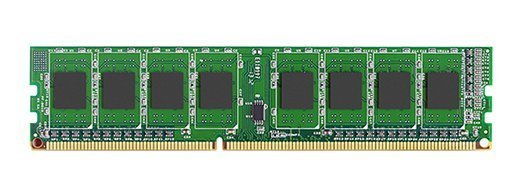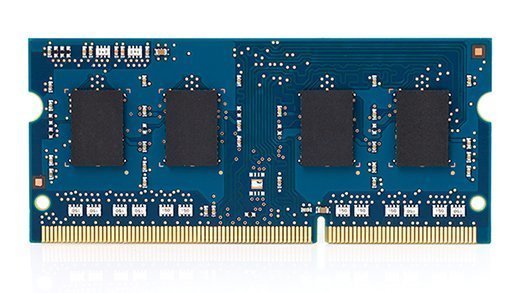What Can a Dimm Use to Hold Data and Amplify a Signal Just Before the Data Is Written to the Module
DIMM (dual in-line memory module) is a blazon of reckoner memory that is natively 64 bits, enabling fast data transfer. DIMM is a module that contains one or several random admission memory (RAM) fries on a pocket-size circuit board with pins that connect it to the computer motherboard. The DIMM stores each data flake in a separate memory prison cell. DIMMs employ a 64-bit data path, since processors used in personal computers have a 64-flake data width. DIMMs are typically used in desktop PCs, laptops, printers and other devices.
A SIMM (single in-line memory module) typically has a 32 data flake (36 $.25 counting parity bits) path to the estimator that requires a 72-pin connector. For synchronous dynamic RAM (SDRAM) fries, which accept a 64 data chip connection to the computer, SIMMs must be installed in in-line pairs, since each one supports a 32-fleck path. A unmarried DIMM can be used instead. Originally, a DIMM had a 168-pin connector to support 64-scrap information transfer.
Equally faster dynamic random access retention (DRAM) was developed, DIMM excursion boards evolved. Modern DIMMs based on double data rate fourth generation (DDR4) SDRAM fries employ 288-pin connectors to adhere to the computer motherboard to enable the increase in data throughput. As clock speeds of the RAM fries increased, the 64-bit path handled increasing amounts of data.
Another evolution in DIMMs is the use of cooling fins or structures attached directly to the DIMM. The increase in chip density in typical 8 GB or 16 GB DIMMS, and the increase in clock speed, led to an increment in rut production. This was fabricated worse past the fact that DIMMs based on DDR4 RAM chips tin exist produced in capacities upwardly to 64 GB.
Cooling structures on the DIMM aid vent that heat into the computer enclosure and away from the motherboard and CPU.

Types of DIMM
The most common standard DIMMs, with a typical length of 5.5 inches and height of ane.xviii inches, are:
- Unbuffered DIMMs (UDIMMs) -- Used mainly on desktop and laptop computers. Although they run faster and cost less, UDIMMs aren't equally stable every bit registered memory. Commands go directly from the retentiveness controller residing in the CPU to the retentivity module.
- Fully-buffered DIMMs (FB-DIMMs) – Usually used as main retentiveness in systems that require big capacities, such as servers and workstations. FB-DIMMs employ advanced retentiveness buffer (AMB) chips to boost reliability, maintain indicate integrity and improve methods to detect errors to reduce soft errors. The AMB bus is split into a 14-bit read passenger vehicle and a 10-bit write autobus. Having a dedicated read/write bus ways reads and writes tin can happen at the aforementioned, which results in increased functioning.
- Registered DIMMs (RDIMMs) -- Likewise known every bit buffered retentivity, RDIMMs are often used in servers and other applications that crave robustness and stability. RDIMMs characteristic onboard memory registers that are placed between the retentiveness and the retention controller. The memory controller buffers control, addressing and clock cycling, and directs instructions to the dedicated memory registers rather than straight accessing the DRAM. Consequently, the instructions could take about one CPU cycle longer. Notwithstanding, the buffering reduces the strain on the CPU's memory controller.
- Load-reduced DIMMs (LR-DIMMs) – Use isolation retentivity buffer (iMB) technology that buffers the data and address lanes, reducing the load on the retentivity controller. The iMB chip also buffers data signals, unlike the register on RDIMMs, which only buffers command, addressing and clock cycling. The iMB chip isolates all electrical loading, including data signals of the DRAM chips on the DIMM from the memory controller. As a outcome, the retentiveness controller merely sees the iMB and not the DRAM fries. The retentiveness buffer then handles all the reads and writes to the DRAM fries, enhancing capacity and speed.
- Then-DIMM -- While the standard DIMM is in the form of a rectangular stick approximately v.5 inches in length, the pocket-size outline dual in-line retentiveness module (SO-DIMM) is most one-half that size at ii.74 inches long. Both types of DIMMs are most commonly 1.ii inches tall, but both are made in a very low profile (VLP) format that is only 0.viii inches alpine. Then-DIMM is mainly used for portable computing devices such as laptops and tablets. It differs from standard DIMM in that the DDR4 SO-DIMM has 260 pins versus 288 pins for the DRR4 DIMM. Standard DIMMs are used in PCs and servers. The VLP DIMM was developed to meet the space requirements of blade servers.

DIMM vs. SIMM
The principal differences between DIMM and SIMM are:
- A DIMM is a double sided SIMM. SIMM tin be installed in in-line pairs while DIMM is contained of the side. Because a DIMM has separate contacts on each side of the lath, information technology provides twice every bit much data every bit a single SIMM.
- SIMM can have a maximum 32-flake channel for data transfer. In dissimilarity, DIMM supports 64-bit channel.
- The amount of ability consumed by SIMM is 5 volts and 3.iii volts for DIMM.
- SIMM modules tin store at maximum 64 bits. On the contrary, DIMM offers upwards to one GB.
- SIMM is outdated engineering. DIMM is used mainly because its performance is better than SIMM.
The future of DIMM
In 2018, the JEDEC standards organization published specifications for DDR5 and several manufacturers accept said that they'll release commercial DDR5 by the end of 2019. DDR5 volition double the top data transfer rates of 25 GBs of DDR4 and use less power than DDR4.
However, DDR5 isn't the only type of DIMM development coming. JEDEC is likewise working on new standards for non-volatile DIMM (NVDIMM) that would retain data during a ability outage. NVDIMMs integrate not-volatile NAND flash retentiveness with DRAM and dedicated backup ability on a unmarried memory subsystem.
Intel and Micron launched 3D XPoint in July 2022 as the commencement new memory architecture in decades. The chips finally shipped in both solid-state drives (SSDs) and DIMMs in May 2019, two years subsequently they were supposed to be launched.
In 2015, some analysts forecast that Intel could become up to $2 billion in revenue in the first ii years later these fries were introduced. However, now they say a more than realistic figure is nearly $200,000 since retentiveness prices accept been collapsing.
Micron is expanding its product capacities produce next-generation memories for side by side-generation applications. The visitor is currently preparing 32 GB memory modules for client systems as well as 64 GB DIMMs for servers based on its 16 GB DDR4 retention chips.
This was final updated in August 2019
Continue Reading About DIMM (dual in-line retentiveness module)
- Diablo provides wink as memory in DIMM slots that act as caches
- Diablo looks to partnerships to push its Memory1 DIMM modules
- Why DIMM could soon overtake PCIe for server-side flash
- Benefits of DIMM vs. PCI Express
Dig Deeper on Storage architecture and strategy
-
![]()
Annual Update on Persistent Memory
-
![]()
Introduction to Big Retentivity
-

Are PMEM and storage class retention worth the price?
-

DRAM (dynamic random admission memory)
Source: https://www.techtarget.com/searchstorage/definition/DIMM



0 Response to "What Can a Dimm Use to Hold Data and Amplify a Signal Just Before the Data Is Written to the Module"
Post a Comment